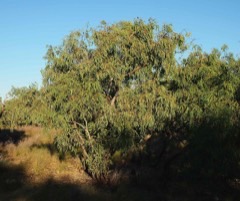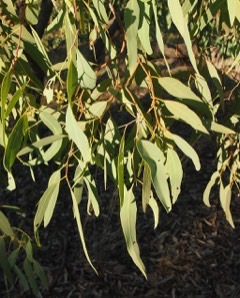 |
|
wikimedia.org Mark Marathon |
 |
| wikimedia.org Mark Marathon |
Translate this page:
Summary
Small to medium tree that can grow large in optimum conditions. Tolerates flooding, heavy soils, alkaline soils and a hot dry site. Great shade tree on larger properties.
Physical Characteristics

 Eucalyptus_microtheca is an evergreen Tree growing to 15 m (49ft) by 10 m (32ft) at a fast rate.
Eucalyptus_microtheca is an evergreen Tree growing to 15 m (49ft) by 10 m (32ft) at a fast rate.
See above for USDA hardiness. It is hardy to UK zone 9. The flowers are pollinated by Insects, Birds.
Suitable for: light (sandy), medium (loamy) and heavy (clay) soils, prefers well-drained soil and can grow in heavy clay and nutritionally poor soils. Suitable pH: mildly acid, neutral and basic (mildly alkaline) soils and can grow in very alkaline soils.
It cannot grow in the shade. It prefers moist soil. The plant can tolerate maritime exposure.
UK Hardiness Map
US Hardiness Map
Synonyms
Eucalyptus raveretiana jerichoensis Domin
Plant Habitats
Edible Uses
The seeds are powdered and made into cakes which are baked and eaten[301 ]. Sap from the roots is used as an emergency source of water for travellers through dry regions[301 ]. The plant is a source of 'lerp' - a sweet, manna-like substance[301 ]. Lerps are waxy scale-like coverings constructed by the immature stage (nymphs) of several species of sap-sucking insects. They serve as a protection whilst the nymphs are feeding and are left behind when the insect pupates. They were a traditional food of the Australian Aborigines[K ].
References More on Edible Uses
Medicinal Uses
Plants For A Future can not take any responsibility for any adverse effects from the use of plants. Always seek advice from a professional before using a plant medicinally.
None known
References More on Medicinal Uses
The Bookshop: Edible Plant Books
Our Latest books on Perennial Plants For Food Forests and Permaculture Gardens in paperback or digital formats.

Edible Tropical Plants
Food Forest Plants for Hotter Conditions: 250+ Plants For Tropical Food Forests & Permaculture Gardens.
More

Edible Temperate Plants
Plants for Your Food Forest: 500 Plants for Temperate Food Forests & Permaculture Gardens.
More

More Books
PFAF have eight books available in paperback and digital formats. Browse the shop for more information.
Shop Now
Other Uses
The heartwood is reddish-brown or reddish; the sapwood is grey[601 ]. The wood is remarkably hard, heavy and elastic[601 ]. It is useful in construction, though perhaps too hard for cabinet-work; it is used for durable poles, fenceposts, bearings, bolts, shafts, frames and wheels[418 , 601 ]. It is neither very much used nor valued[601 ]. The wood is used for fuel and to make charcoal[418 ]. The trees have a dense, rounded shape making them wind resistant and useful as windbreaks and to control erosion. They are one of the more commonly planted eucalyptus species in the southwestern United States since they are fast and easy to grow. Able to tolerate full sun, withstand temperatures below freezing and grow in soils with poor fertility makes them easy to grow.
Special Uses
References More on Other Uses
Cultivation details
A plant of the arid and semiarid tropics and subtropics, where it is found at elevations up to 1,000 metres. It grows best in areas where annual daytime temperatures are within the range 24 - 39?c, but can tolerate 5 - 45?c[418 ]. It can be killed by temperatures of -4?c or lower, though new growth will be damaged if the temperature falls to zero[418 ]. It prefers a mean annual rainfall in the range 250 - 1,---mm, but tolerates 150 - 1,200mm[418 ]. Requires a sunny position[418 ]. Succeeds in most soils of at least moderate fertility[418 ]. Prefers a pH in the range 6.5 - 8, tolerating 6 - 9[418 ]. The plant often experiences inundation for part of the year and is also able to withstand up to 7 months drought[418 ]. A potentially very fast-growing species if there is sufficient water, on suitable sites the growth may reach 3 metres per year[418 ]. Under irrigation it should be possible to grow the tree in deserts[418 ]. The tree can be harvested after 8 years from a seedling crop and after 6 years from subsequent coppice crops[418 ]. Annual wood production potential is 3 - 7 m3/ha[418 ]. The tree is fire tender[418 ]. Eucalyptus species have not adopted a deciduous habit and continue to grow until it is too cold for them to do so. This makes them more susceptible to damage from sudden cold snaps. If temperature fluctuations are more gradual, as in a woodland for example, the plants have the opportunity to stop growing and become dormant, thus making them more cold resistant. A deep mulch around the roots to prevent the soil from freezing also helps the trees to survive cold conditions. The members of this genus are remarkably adaptable however, there can be a dramatic increase in the hardiness of subsequent generations from the seed of survivors growing in temperate zones[200 ]. Eucalyptus monocultures are an environmental disaster, they are voracious, allelopathic and encourage the worst possible attitudes to land use and conservation[200 ]. E. microtheca is most closely related to the widespread Eucalyptus coolabah which is found in similar but drier habitats to the south and south-east It is also closely related to Eucalyptus victrix which is found in even drier habitats from central Australia west to the Pilbara region of Western Australia. Drought tolerant once established
References Carbon Farming Information and Carbon Sequestration Information
Temperature Converter
Type a value in the Celsius field to convert the value to Fahrenheit:
Fahrenheit:
The PFAF Bookshop
Plants For A Future have a number of books available in paperback and digital form. Book titles include Edible Plants, Edible Perennials, Edible Trees,Edible Shrubs, Woodland Gardening, and Temperate Food Forest Plants. Our new book is Food Forest Plants For Hotter Conditions (Tropical and Sub-Tropical).
Shop Now
Plant Propagation
Seed - surface sow in a sunny position and make sure the compost is not allowed to dry out[11 , 78 , 134 ]. Species that come from high altitudes appreciate 6 - 8 weeks cold stratification at 2?c[200 ]. Pot up the seedlings into individual pots as soon as the second set of seed leaves has developed, if left longer than this they might not move well. The seedlings are ready for planting in the field when they are 25 - 30 cm tall, usually after 3 - 4 months. The seed has a long viability[200 ].
Other Names
If available other names are mentioned here
Coolabah. Coolibah
Native Plant Search
Search over 900 plants ideal for food forests and permaculture gardens. Filter to search native plants to your area. The plants selected are the plants in our book 'Plants For Your Food Forest: 500 Plants for Temperate Food Forests and Permaculture Gardens, as well as plants chosen for our forthcoming related books for Tropical/Hot Wet Climates and Mediterranean/Hot Dry Climates. Native Plant Search
Found In
Countries where the plant has been found are listed here if the information is available
Africa, Asia, Australia, India, Iran, Iraq, Morocco, North Africa, Pakistan, Sudan, Tunisia, USA,
Weed Potential
Right plant wrong place. We are currently updating this section.
Please note that a plant may be invasive in one area but may not in your area so it’s worth checking.
None Known
Conservation Status
IUCN Red List of Threatened Plants Status : This taxon has not yet been assessed

Growth: S = slow M = medium F = fast. Soil: L = light (sandy) M = medium H = heavy (clay). pH: A = acid N = neutral B = basic (alkaline). Shade: F = full shade S = semi-shade N = no shade. Moisture: D = dry M = Moist We = wet Wa = water.

Expert comment
Author
F.Muell.
Botanical References
Links / References
For a list of references used on this page please go here
A special thanks to Ken Fern for some of the information used on this page.
Readers comment
| Add a comment |
|
If you have important information about this plant that may help other users please add a comment or link below. Only comments or links that are felt to be directly relevant to a plant will be included. If you think a comment/link or information contained on this page is inaccurate or misleading we would welcome your feedback at [email protected]. If you have questions about a plant please use the Forum on this website as we do not have the resources to answer questions ourselves.
* Please note: the comments by website users are not necessarily those held by PFAF and may give misleading or inaccurate information.
To leave a comment please Register or login here All comments need to be approved so will not appear immediately.
|
Subject : Eucalyptus_microtheca
|
|
|
|